The Old Darlinghurst Gaol: A Tour
I’ve wanted to do a tour of the Old Darlinghurst Gaol ever since I ventured through the big sandstone archway into the grounds of the gaol as part of my Darlinghurst exploration. I knew that if the walls could talk there would be stories aplenty.
The National Art School
At last, I am on my way to the gaol, which has been the home of the National Art School for 100 years, to learn more about the buildings and hear some of the stories.


Initially I am disappointed to see the main entrance closed. Scaffolding and building hoardings hide the sandstone façade. The walls and entrance are being restored. But, as part of the City of Sydney Creative Hoardings program, the National Art School has decorated the hoardings with historical photographs and information about the goal.
Restoration Work
I take my time to read the blurb and inspect the photographs. Across the road, two men wearing workwear with NSW Heritage Stonework insignia, watch on. One calls out and asks “What interests you about the building”?
We chat about the building and its history. They are stonemasons and explain that they have restored a large section of the wall, but today are working on the coat of arms. They will drill holes into the coat of arms. Then poles will be put through the holes to support the coat of arms when a crane lifts it off to take it away for restoration.
Incidental meetings like this make my exploration of Sydney so much more fun.
The Tour
The tour today is part of an open day celebrating 100 years of the National Art School.


Our guide, Justin Watson, tells us that it’s not unusual for visitors and new students to get disoriented when they first come to the Old Darlinghurst Gaol. The complex has a radial design with wings radiating out from the round central chapel. One wing looks like the next. When standing against the curved chapel wall, there’s little to indicate which wing you’re facing.
Building the Gaol
We learnt that the gaol was built when the first gaol in Sydney (it stood where the Four Season’s Hotel now stands), was run down and over crowded and needed replacing. Construction of the new 6.5m high goal walls began in 1822. There was a period when building stopped. It was then completed over a period of time with the first prisoners incarcerated in 1841 before the gaol was finished in 1885.
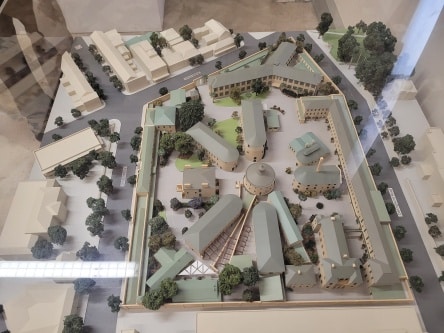

Built on the highest point in Sydney, the goal could be seen from all over Sydney. Justin suggests this was perhaps as a warning to the people toiling below. The prison closed in 1914 and since 1922 has been home to the National Art School of Sydney. Prisoners were relocated to Long Bay Jail.
The Cell Block Theatre
Justin leads us into the Cell Block Theatre where we sit on the edge of the low black stage and look around. This block held female prisoners. Women were usually short-term prisoners, often incarcerated for having “no visible means of support” in other words, for prostitution.


The Cell Block was gutted in the 1920s, but indications of it’s original use remain. Rusty metal pegs in the wall at one end used to hold the padding for a padded cell in place. There were 36 double cells and six single cells over three levels. Small high barred ‘windows’ let in light. Behind the stage I make out the remnants of a cantilevered staircase.
Katharine Hepburn and Robert Helpmann both visited the theatre to assist in fundraising for repairs and reroofing.
The Exercise Yard
From the cell block, Justin leads us through a green metal gate into a narrow exercise yard attached to the wing. Women didn’t leave their wing except to ‘exercise’ in this yard and to go to chapel via a door and ‘bridge’ from the wing to the chapel. We exit through another doorway, this one guarded by a heavy metal door. It’s not hard to imagine the misery of the women incarcerated here.
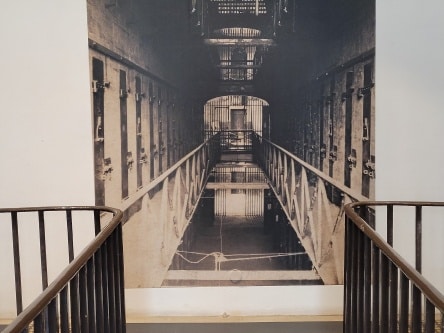

A Workplace
Male prisoners often worked in various trades. Justin takes a deep breath and lists in alphabetical order the thirteen trades that were practiced here. They include blacksmithing, bookmaking, brick making, carpentry, printing, tailoring, and shoe making. A long building on one side of the complex made up the workshops.
The Chapel
I follow Justin up carpeted wooden stairs to the chapel. Light filters onto the wooden floor from high rectangular windows. Wooden easels line the curved wall. Stained glass windows, designed by colonial architect James Barnett, decorate one wall. Female prisoners entered the chapel through a doorway high up in the wall which today seem to lead nowhere. They sat in a gallery (no longer there) separated from the men who were seated below.
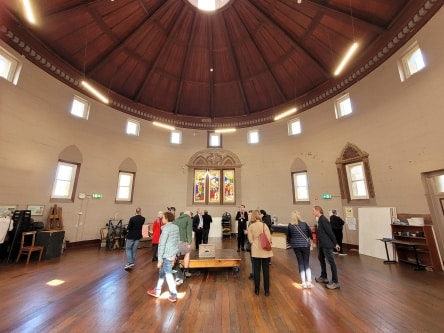

Underneath the chapel was the bathhouse and reception area. Today the room is dedicated to drawing.
A Prisoner enters Darlinghurst Gaol
Justin explains that prisoners were brought to the goal in a Black Mariah or paddy wagon. They drove through the sandstone arch and pulled up in front of the imposing three-storey Governor’s residence. Guards led the prisoner down stairs and into a tunnel under the residence. The idea was to reinforce to the prisoner their lowly status and the power of the Governor.


We walk through the tunnel which Henry Lawson, who was jailed here, described as a sandstone tomb. The walls are free of grime and an electric light brightens our way. It’s dry and dusty. I start to cough.
At one point, Justin turns off the electric light. The sudden darkness gives us an insight into how prisoners might feel as they were led to the bathhouse. New prisoners were relieved of their clothes, bathed and deloused before being escorted to their cells. The other tunnel in the goal leads to the adjacent courthouse.
A Sad and Brutal Place
Justin talks about conditions at the gaol. It was a sad and brutal place. Many people who were incarcerated here ended up being transferred to what was then called a lunatic asylum. Justin shows us the gallows where over 70 men and one woman were hung. The tour gets a bit gruesome here, and Justin invites anyone who is squeamish to leave before he describes the hanging process. The hangman didn’t always get it right.
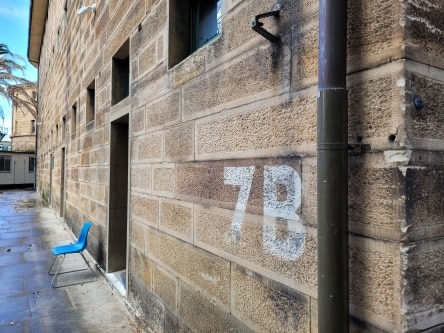

There’s so much more to see in the gaol complex. We see the entrance to the tunnel that leads to the courthouse and the last remaining sentry tower. We walk past the library, the engine house, the kitchen garden and hospital scullery. These are all repurposed for use by the Art School.
Things Come Full Circle
It’s funny how things come full circle. One of the Governors, Cecil Read, encouraged prisoners to draw. Henry Bertrand, the ‘Demon Dentist’, killed his lover’s husband. He is credited with being the first artist of Darlinghurst Gaol. Today aspiring artists walk the paths of the old gaol, and practice their craft in old cell blocks and workshops.
Previous Students of the National Art School
Margaret Olley and Martin Sharpe are amongst the well-known Australian artists who studied here. A couple of women in our group learnt to cook or sew here, and when asked if anyone had a relative incarcerated here, at least one hand goes up.


An Enjoyable Informative Tour
This tour has been a fascinating insight into the Old Darlinghurst Gaol. I leave feeling energized with my newfound knowledge of another park of Sydney’s recent history.
Useful Information
- My tour of the Old Darlinghurst Gaol was part of the centenary celebrations of the National Art School.
- While I could not find any information about ongoing tours, I was told that tours of the Old Darlinghurst Gaol have restarted. Call 02 9339 8609 for more information.
- The tour included the Cell Block Theatre, the Chapel, the old Governor’s residence, the morgue, the tunnel which was used to process and delouse prisoners and the site of the former gallows.
- Tours include rough, uneven surfaces and stairs.
- While you can walk through the National Art School yourself, the places shown on the tour are not always open to visitors.
If you enjoyed reading about the Old Darlinghurst Gaol then you might enjoy reading about my tour of Maitland Gaol here.
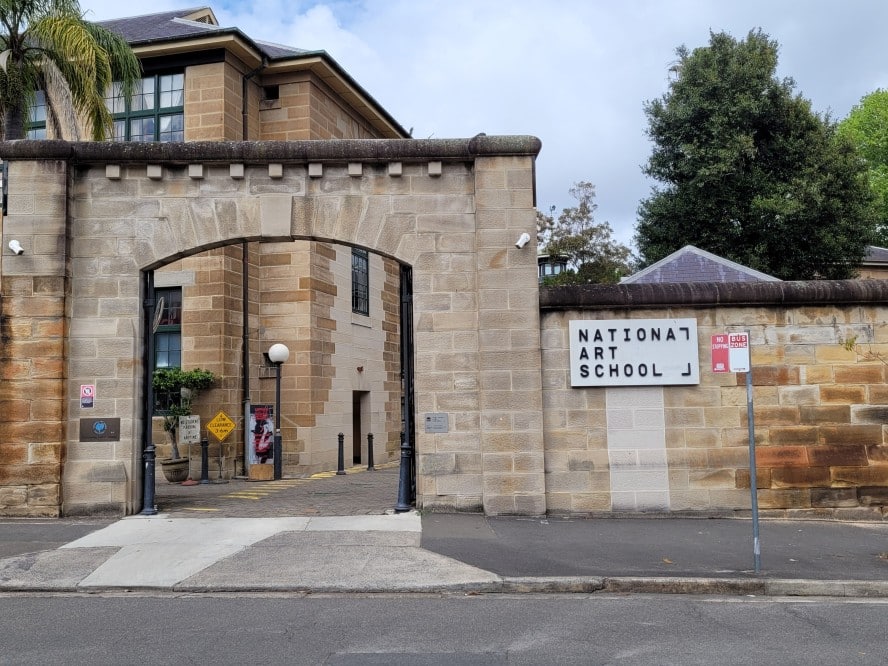
I have been wanting to do that tour for ages too Joanne. I made do in the meantime buying a book about its history from the shop there. Interesting post. Thanks
I was lucky, Lyn. An email in my inbox told me about the tour.
Thank you very much Joanne , booked for this weekend ?
Pleased to hear that. Enjoy the tour, Arlene
Would love to go on a tour of this place. Drove by the last time I was in Sydney and wondered how I could get in there!
It’s such an interesting place Erica. In the past I have just walked in!
Better to be there as part of the National Art School or a visitor touring. Must have been grim to be a prisoner there. Its an amazing building.
It is a fascinating building,Bernadette. I’m so pleased I finally got to do a tour.
A wonderful insight into our history. Looks and sounds, well worth a visit.
Thank you Joanne.
Definitely, Kerrie. I’m actually going again soon with Sydney Greeters.